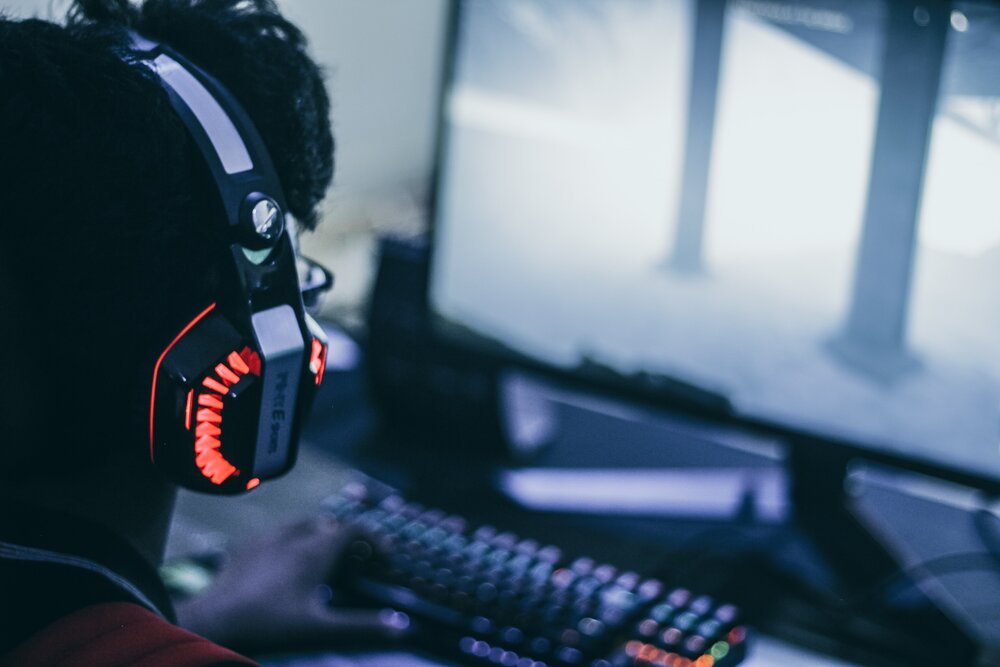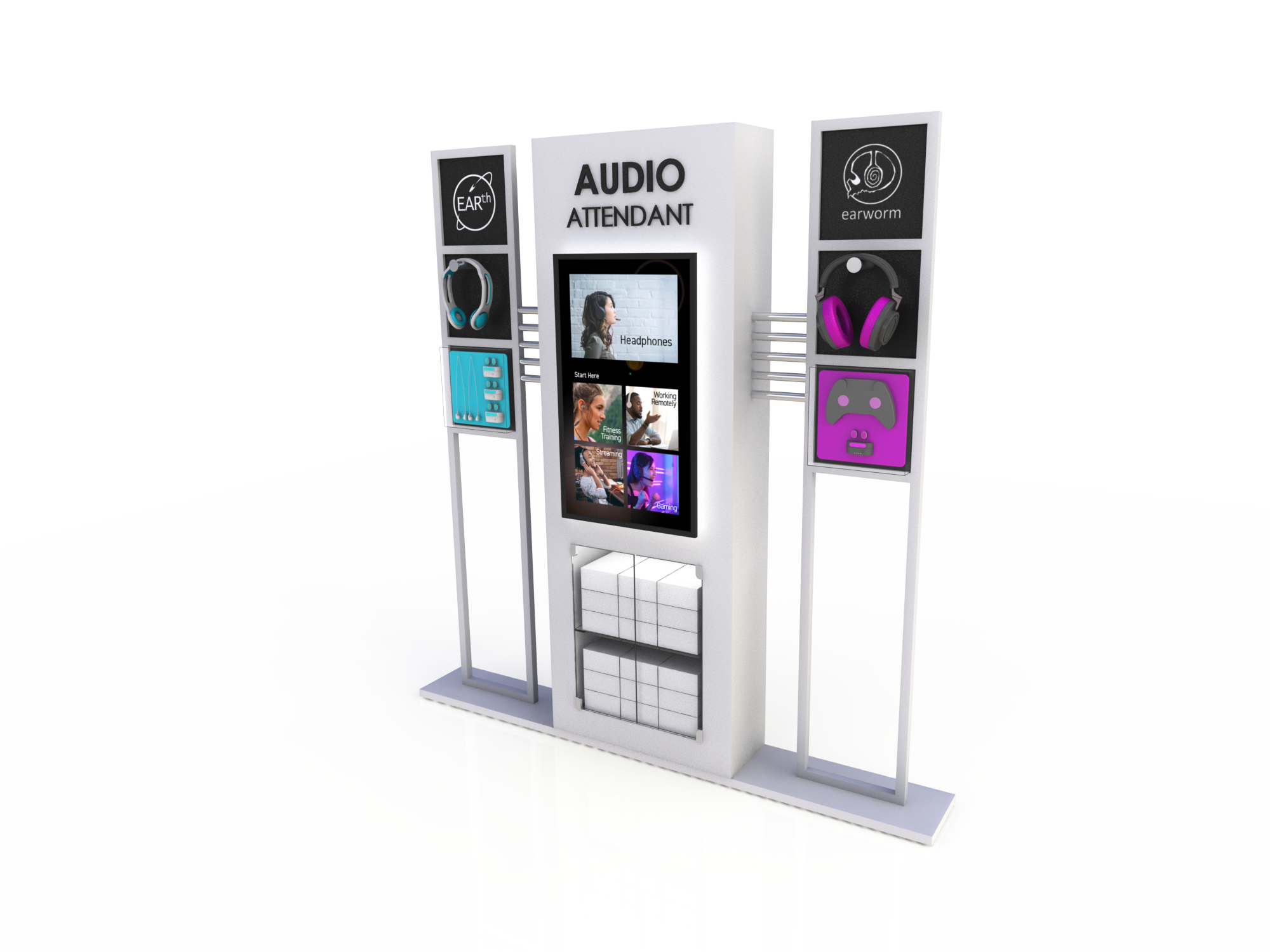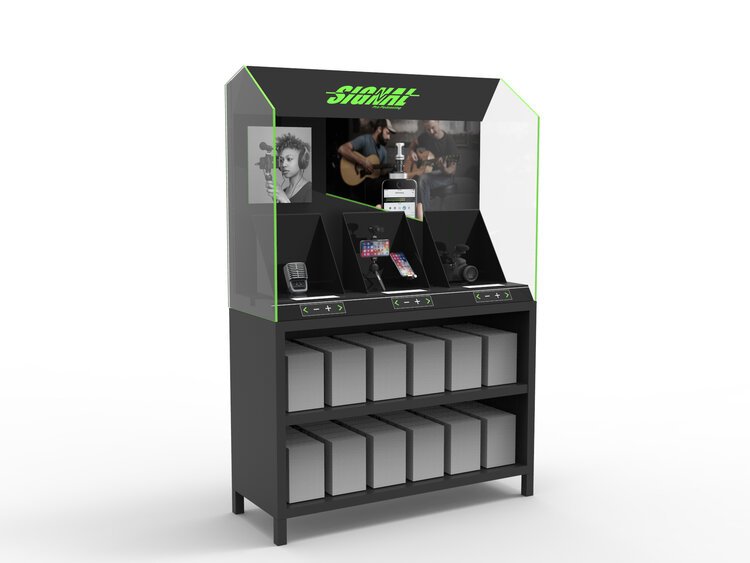Retail Guide: Consumer Audio Retail
PEOPLE LOVE TO BE CONNECTED.
To each other and to their devices. To their creativity and to their passions. People also love products that help them achieve this connection. Retail makes that possible.
IN THIS ARTICLE:
Consumer Audio OVERVIEW & Industry Insight
Tech Trends Affecting Consumer Audio
Retail Innovation for Consumer Audio Brands and Retailers
Display, Fixture, and Visual Merchandising Inspiration
Consumer Demand
Recently, we put together a retail display guide for the musical instrument market. Now, we’re taking another look at music retail and focusing on how people use headphones, earbuds, and wireless speakers to connect to the world within and around them.
Of all the categories of consumer electronics, consumer audio is one of the most diverse and multifaceted. Musicians, gamers, remote workers, content creators, commuters, lovers of the outdoors, and athletes alike rely on personal audio products to expand their lives and lifestyles.
As consumers’ ears become just as important as their eyes, audio brands and retailers must work together to determine the best way to bring new products to life at retail.
The Role of Sound in the lives of consumers
From the moment we wake up to the moment we go to sleep, we are connected to a device.
As wireless technology advances, consumer audio products like headphones, earbuds, and Bluetooth speakers accompany us as we do just about anything. From morning workouts, to afternoon murder mysteries, to evening meditations, audio products have shifted from “nice-to-haves” to necessities. Sound is an integral part of our life experience.
Because of that, consumers have grown pickier in what they expect from a product. We want great sound quality, device compatibility, simple use, and a comfortable fit. We demand affordability, long battery life, and eye-catching aesthetics.
These expectations, coupled with the rise of e-commerce and consumers’ exposure to nearly limitless product options, drive how brands and retailers innovate product lines, provide value, and create loyalty in this market.
Brick and mortar retail creates opportunities for consumer audio manufacturers to connect with shoppers through their senses. By developing retail display and merchandising systems that are as interesting and informative as they are recognizable and entertaining, brands can better reach shoppers no matter where they are on their path to purchase.
The remainder of this piece overviews retail trends affecting this industry, uncovers shared pain points across categories, and provides a few inspirational concepts to aid in retail design conversations.
Industry Insight
The industry consisting of headphones, earbuds, hearables, and wireless speakers is poised to grow by $8.23B over the next four years. “Globally, the most in-demand personal electronic devices are smart phones, smart speakers, and true wireless earbuds” (Qualcomm).
According to Qualcomm’s State of Sound 2022 report, “sound has never been more important.” As humanity embarks on life post-Covid, continued shifts in work, commute, school, travel, and entertainment behaviors affect what consumers expect out of their devices and contribute to changing preferences in audio products and features.
Survey respondents report price as an increasingly important purchasing factor (10% increase year-on-year), though sound quality still remains #1 across the board
Broader spread of feature interest, especially in noise cancellation, high-resolution options, and comfort features
8+ hours of battery life is the new gold standard
High demand for truly wireless products, especially earbuds. This demand is reflective of a diversification of wireless headphone usage cases which has impacted consumer shopping decisions dramatically
Smart (voice-enabled) speakers are now the most sought-after speaker
Product usage for video content and gaming audio significantly rose year-on-year (2nd use case for headphones, 3rd for earbud)
Technology Maturation
Even before March 2020, this industry was no stranger to change. The recent boom in more advanced technologies such as AR/VR, AI/ML, IoT, cloud-based voice assistants, wireless/TWS technologies, etc., paired with the rate in which tech-enabled products have made their way into consumer homes has caused a new product explosion throughout industries.
From thermostats to washing machines, cars to lightbulbs, consumers have gotten used to the extra set of virtual hands summoned by a quick, “Hey, Alexa.” This technology is increasingly included in our speakers, headphones, hearables, wearables, and other audio devices, impacting consumer demand for voice-assisted audio products - products that help people with their everyday life, like listening to music, working, learning, video chatting, livestreaming, tracking wellness goals, cooking, and more.
As human and machine continue to morph, consumers will come to demand greater cohesion between their products and devices. In fact, 54% of consumers polled in the State of Play Report said they are likely or extremely likely to purchase wireless headphones or earbuds that offer additional features, such as voice assistant, fitness biometrics, or hearing assistance capabilities.
All Eyes, Ears, and Emotions on Immersive
From an entertainment standpoint, advanced technologies are redefining how people experience the “experiential.” While many have come to associate VR and AR with primarily visual elements (think virtual reality headsets), advancements and innovation in immersive audio have radically expanded what’s possible for gaming and consuming video content in today’s age. More often than not, product innovation is focused on seamless syncing capacities and compatibility features so that listeners are brought into a robust, interconnected platform able to take them outside of one world and into another.
Immersive audio innovation is relevant for simpler things too, such as everyday music streaming. A great example to illustrate the difference between traditional stereo audio and immersive audio is in Sony’s latest technology - 360 Reality Audio. This was a big hit at CES 2021.
Check out the website here.
Opportunities for Consumer Audio Brands and Retailers:
As new products and technologies develop, consumer audio brands and retailers have an opportunity to reimagine impactful ways to bring benefits, differentiators, and wow factors to life throughout channel retail settings. Product discoveries and advancements are rapidly carving out new spaces and niches in existing audio categories - areas that will require new education, training, and demo capacities for both store associates and consumers. To navigate this learning curve together, the role of the store must bridge the gap between curiosity and confidence.
Additionally, the rise of e-commerce and digital engagement throughout paths to purchase have skyrocketed since the pandemic. Though stats vary among demographic factors (i.e., age, gender, occupation, socioeconomic status, etc.), overwhelmingly, 2020 solidified the fact that most people can bypass an in-store experience for most things if they have to. The question is, do they want to?
Consumer audio retail has the capacity to give consumers a reason - a motivation - to visit a store. Selecting a product that will, in some regard, become an extension of oneself is an important purchase. Regardless of product category, store location or setting, marketshare or other categorical notation, product manufacturers and their retail channels can secure consumer confidence by:
Offering experiential education - we cannot rely on signage and touchscreens to do the work. Consider implementing environmental designs that guide customers into a mindset - into a state-of-being - that gets both right brain and left brain activated
In the same sense, creating a personal connection and/or attachment through scenario-based merchandising and selling helps customers imagine how the product specifically interacts with and enhances with their own lives. Set up easy smart-phone compatibility checks. Create a fun way to test range. Develop a “battery drain” simulator. Use AR to walk people through how a smart speaker allows them to control all of their at-home smart devices. Bring a treadmill in and figure out how to demo products for the active consumer.
Ambitious? Maybe. But universally, consumers are demanding the same features/benefits out of their consumer audio products. Brand loyalty will disintegrate if not enough is done to steer attention and interaction to purchasing drivers and away from hesitancies related to purchasing barriers. If we want to restore, keep, or earn consumer confidence, we have to prove it. This is a potential big win for brick and mortar over e-commerce or DTC.
Bringing demo and testing abilities to life in-stores (a barrier to online purchasing for many)
Ensuring demo and testing abilities are safe and sanitized (a barrier to in-store purchasing for many)
Embracing, not separating nor excluding, e-commerce and digital integrations, and making them a cornerstone of the in-store experience
Investing in display systems and retail programs that are highly adaptable to keep up with rapid new product rollouts, promos, and launches without “reinventing the wheel” each quarter or buying season. Do it really well once, shift into a plan of continual adjustment
Inspiration Gallery
The solutions below are meant to apply creative problem-solving to generally shared consumer audio retail challenges. We understand each product, brand, and retail channel has specific needs.
Use this non-exhaustive idea bank to get thinking about the role of brick-and-mortar in this next era of experiential audio.
CONCEPT: “BREAK TRADITION, ENCOURAGE CONNECTION”
People are engaged with their consumer audio products in more ways, for more reasons, and in more places than ever before. As product usage continues to diversify, retail has the opportunity to color outside the lines and break the traditional “siloed” approach to merchandising and display.
Transitioning a traditional and expected categorical retail marketing approach in favor of one that is more fluid, partner-driven, and relationship-orientated benefits brand-to-brand, brand-to-retailer, and consumer-to-product scenarios in multiple ways. Instead of simply selling products off shelves, we have an opportunity to recreate lifestyle ecosystems that showcase a multitude of complementary brands, products, accessories, and services cognizant to a consumer’s natural thought process and needs.
For example:
Major headphone manufacturer develops a partnership with a major game console brand, such as XBOX, PlayStation, or Nintendo for a national retail installation. Either as a pop-up environment or vignette-style display area, promote the story of how top quality headphones make a noticeable impact in play experience. Bonus: keep an inventory of gaming consoles, controllers, and other accessories in stock for purchase. Double bonus: connect this in-store experience to a social media push offering incentives to come in-store and unlock special promotions.
This pop-up environment/vignette-style display is a multi-purposed design idea. Once the promo period ends for the two brands, the elements and space could easily be repurposed for additional brand-to-brand promotions, or it could become a “feature area” for the retailer where store staff or corporate can decide what products and promotions to rotate in and out of the area. Pictured is a relatively low-tech environment, however, the display could easily be designed to include more interactive elements if needed.
Another way brands and retailers can merchandise beyond product category and help consumers create a personal connection with and attachment to products is by presenting products based on consumer demand. In other words, consider reimagining “brand blocking” by organizing products based on top purchasing drivers and usage scenarios, such as “best for streaming,” “best for active lifestyles,” battery life, smart phone compatibility, etc.
Image 1 - Retailers can adopt this strategy by showcasing multi-brand, multi-product display environments that encourage brand-agnostic, feature-driven shoppers to explore and connect to a wider product range.
Image 2 - Since the display can be built with modularity in mind, parts of it can be broken off or moved around to showcase specific brands. Pictured here is an instance where a brand’s entire product line is displayed for a variety of uses. Usage could easily be swapped out to showcase features, such as battery life, if desired.
Not shown but also possible would be to take a usage scenario or purchase driver, such as noise cancellation, and repurpose the “Earworm” header in Image 2 to say “Noise Cancellation.” Add some educational signage/comparison charts overviewing key considerations as to what makes for good noise cancellation, and then show multiple brands with their associated best in class product(s) for this particular feature.
A note: no matter the scenario, the fate of many retailers often lies within the hands of the brand.
When brands invest into their display programs and bring new ideas to the table, they have the potential to elevate entire sections of stores and inspire positive change across the board.
Sales, consumer loyalty, and employee morale tend to increase, making the overall store experience better, more relevant, and likely to be re-visited. Whether you are a brand looking to better support your retail channel or a retailer looking to strategize your brand partnerships, space allotment, or other, AXIS has experience improving things for all. See this thinking in action for Polaris dealers or through the relationship between a kayak company and Dick’s Sporting Goods.
CONCEPT: “EXPLORE, EXPERIENCE, ENJOY”
A one-size-fits all approach to how people learn about, engage with, and purchase products does not exist. In order to bridge the gap between curiosity and confidence, brick and mortar retailers have an opportunity to guide, influence, and capitalize on the shopping experience whether it begins at-home online, in-person in store, or through another means.
Whether in a physical or digital setting, endless options, feature fatigue, and decision paralysis lowers consumer confidence. When confidence is low, dissatisfaction increases ultimately impacting overall brand experience and consumer loyalty – not to mention the cost of returned inventory or poor reviews. Let’s avoid this.
Beef up the traditional interactive kiosk.
Create a modular display system that situates a tech-agnostic interactive kiosk as the cornerstone. This kiosk could utilize touch, voice, or other technology, and feature a scannable QR code giving the viewer the option to view the same content on their personal device if preferred. The remotely updated content runs a product selection program based on a variety of easily updated metrics such as product use, feature, price, customer reviews, promotions, etc. This could be done through a self-directed survey, questionnaire, or gamified experience.
Once the customer has explored and narrowed down personalized options, the kiosk directs them to how and where they can demo the product.
If the product is in-store and available to be tested, the kiosk informs the customer to “Experience Now!” The customer would be directed to the in-store display where the product in question is located. Pictured below are examples of various display formats that could be adopted to any brand for any use case. For illustrative purposes, we’ve shown what some of these demo and education environments could look like in-store for one brand, Signal.
Images 1 & 2 - may make sense if one of the kiosk scenarios is “Podcasting”
Image 3 - may make sense if one of the kiosk scenarios is“Livestreaming”
Image 4 - may make sense if one of the kiosk scenarios is “Content Creating”
Image 5 - may make sense if the kiosk program helped someone narrow options by features, such as sound quality, price, or comfort
Either independently or with the help of a store associate, customers get to engage with their options right away all in one area.
If the narrowed down product is not available in-store, or if safety regulations prohibit a demo experience, the kiosk presents the customer with an option to schedule an appointment to come in and have a concierge-inspired, one-on-one demo experience with a “sound expert” (i.e., a store associate).
Upon arrival, selected products would be set aside and sanitized for the customer. Throughout the appointment, additional products and accessories could be discussed and demoed, promoting the opportunity for upsell while also establishing a more genuine connection between brand and consumer due to human interaction.
This dedicated space helps facilitate customer identification with and attachment to products, while also providing privacy and personalized customer service. Additionally, if concierge-type demo appointments phase out or are otherwise no longer needed, this flexible space becomes the perfect footprint to feature product lines, categories, promotions, or other service-oriented in-store initiatives.
In providing this type of kiosk technology and supporting it by (1) developing a display system that is easily scaled and updated to support new products and rotating inventory needs, (2) incorporating bold branding and educational messaging, and (3) carving out a special area to have a one-on-one personalized interaction with a sales associate, we put everything a customer may encounter on their path-to-purchase into a single ecosystem built to predict their natural questions and provide customer service that exceeds expectations.
Additionally, the same product selection software available in the in-store kiosk can also be accessed via the brand or retailer’s website, landing page, or social marketing campaign, giving the consumer control of how they navigate their own process while also motivating them to “start at home, set an appointment, and finish up in store.”
















